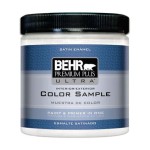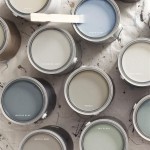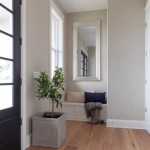What Color to Paint Inside of House: A Comprehensive Guide
Selecting the appropriate color palette for the interior of a house is a significant decision that can profoundly impact the overall aesthetic, mood, and perceived value of the property. This choice extends beyond mere personal preference and requires careful consideration of various factors, including natural light, the function of each room, existing furnishings, architectural style, and desired ambiance. The ultimate goal is to create a cohesive and harmonious environment that reflects both the homeowner's style and the inherent character of the house.
The process of choosing interior paint colors should begin with a thorough assessment of the existing space. This involves evaluating the amount of natural light each room receives, the size and shape of the rooms, and the colors of existing furniture, flooring, and architectural details. Understanding these elements is crucial for making informed decisions that will enhance the overall appeal and functionality of the living space. A well-considered color scheme can visually expand small rooms, brighten dark spaces, and create a sense of cohesion throughout the house.
Understanding the Impact of Color Psychology
Color psychology plays a vital role in interior design, influencing moods and perceptions. Different colors evoke distinct emotional responses, and understanding these associations is essential for creating a desired atmosphere in each room. For instance, blue is often associated with calmness and tranquility, making it a popular choice for bedrooms and bathrooms. Green, on the other hand, is linked to nature and relaxation, making it suitable for living rooms and home offices. Red is a vibrant and energetic color, often used sparingly as an accent to add excitement and warmth to a space. Yellow is associated with happiness and optimism, making it a good choice for kitchens and dining areas, but it should be used cautiously as excessive yellow can be overwhelming. Neutral colors, such as white, gray, and beige, provide a versatile backdrop that allows furniture and accessories to take center stage, offering flexibility and enabling the introduction of pops of color through artwork and décor.
When selecting paint colors, it is essential to consider the intensity and saturation of the hues. Bright, saturated colors can be stimulating and energizing, while muted, desaturated colors tend to be more calming and soothing. The choice between these options depends on the desired atmosphere for each room. For living rooms and bedrooms, softer, more muted tones are often preferred to create a relaxing environment. In contrast, kitchens and dining areas might benefit from slightly brighter colors to stimulate appetite and conversation. The impact of color psychology can be significantly amplified when used strategically in conjunction with lighting and architectural features.
It’s crucial to test paint colors in the actual room before committing to painting the entire space. The same color can appear different under varying lighting conditions. Paint a large swatch of the color on a wall and observe it throughout the day and night to see how the light affects its appearance. This process will help ensure that the chosen color complements the room's natural light and existing décor, preventing potential disappointments later on. Similarly, factors such as flooring material and the color of trim can influence your perception of a paint color, making it worthwhile to consider these elements before making any final decisions. It's also a good habit to examine color palettes in different lighting conditions and at various times of the day.
Considering Functionality and Room Size
The function of each room dictates, to some extent, which colors are most appropriate. Bedrooms, for example, ideally require colors that promote relaxation and sleep. Soft blues, greens, and grays are often recommended for this purpose. Living rooms, on the other hand, can accommodate a wider range of colors, depending on the desired ambiance. Warm neutrals, such as beige and cream, create a cozy and inviting atmosphere, while bolder colors, such as deep blues or greens, can add drama and personality. Kitchens and dining rooms benefit from colors that stimulate appetite and conversation. Warm yellows and oranges are often used in these spaces, but softer, more muted tones can also be effective. Bathrooms are typically painted in light, airy colors, such as white, light blue, or pastel green, to create a clean and refreshing atmosphere. Home offices require colors that promote focus and productivity. Neutral colors, such as gray or beige, are often preferred, but subtle hints of blue or green can also be beneficial.
Room size also plays a significant role in color selection. Light colors tend to make rooms appear larger and more open, while dark colors can make rooms feel smaller and more enclosed. In small rooms, it is generally advisable to use light colors to maximize the feeling of spaciousness. White, off-white, and light pastel shades are excellent choices for small bedrooms, bathrooms, and hallways. In larger rooms, darker colors can be used to create a more intimate and cozy atmosphere. Deep blues, greens, and grays are suitable for large living rooms and bedrooms. However, it is important to use dark colors judiciously to avoid making the room feel oppressive or gloomy. Consider using dark colors on accent walls only, or pairing them with lighter colors to balance the overall effect.
Beyond the general guidelines, it's vital to consider the furniture, decor, and architectural style of the building. If the style of the house is modern, you might lean toward cleaner, bolder colors. If the style is more traditional, you might opt for softer, more subdued tones. The color of the furniture should also be taken into account. If the furniture is brightly colored, it's a good idea to choose a neutral paint color that won't clash. If the furniture is neutral, you can be more adventurous with the wall color. The same applies to the architectural style of the room. A room with a lot of natural light can handle darker colors, while a room with little natural light needs lighter colors to brighten it up.
Harmonizing Colors and Creating Cohesion
Creating a cohesive color scheme throughout the house is essential for achieving a harmonious and unified look. This does not necessarily mean painting every room the same color, but rather selecting a palette of colors that complement each other and create a sense of flow from one room to the next. There are several strategies for achieving color cohesion, including using a consistent color family, employing a neutral base with accent colors, and creating visual connections between rooms.
One effective approach is to choose a color family and use variations of that color throughout the house. For example, you might choose a blue color family and use different shades of blue in various rooms. A light blue might be used in the bedrooms, a medium blue in the living room, and a dark blue in the dining room. This approach creates a sense of unity while still allowing for individual expression in each room. Another strategy is to use a neutral base color, such as white, gray, or beige, throughout the house and then add accent colors in each room. The accent colors can be used in furniture, artwork, and accessories, as well as on accent walls. This approach allows for a consistent backdrop while providing opportunities to introduce personality and interest.
Visual connections between rooms can also contribute to color cohesion. This can be achieved by using the same accent color in adjacent rooms or by repeating architectural details, such as trim or moldings, in the same color. For example, if the living room has a blue accent wall, you might use blue cushions or artwork in the adjacent dining room. Similarly, if the trim in the hallway is painted white, you might use the same white paint for the trim in the bedrooms. These subtle connections can create a sense of flow and continuity throughout the house. Consider also the importance of the ceiling and floor colors. A white ceiling can reflect light and make a room feel bigger, while a darker floor can ground the space. The colors of these elements can work together to enhance the overall aesthetic and create a sense of balance and harmony.
Ultimately, selecting the right paint color involves a combination of understanding color psychology, considering the functionality and size of each room, and creating a cohesive color scheme throughout the house. By taking these factors into account, homeowners can create living spaces that are both beautiful and functional, reflecting their personal style and enhancing the overall value of their property. The right colors can transform a house into a home, creating a warm, inviting, and harmonious environment for years to come.

Choosing The Perfect Interior Paint Color Artisan Builders

Lake House Interior Colors The Lilypad Cottage

20 Of The Best Paint Colors For Whole House Welsh Design Studio

Choosing The Best Interior Paint Colors For Your Home In Fair Oaks Ranch

How To Choose Interior Paint Colors For Your Home

Using White As A Color For Interior And Exterior Painting

Best Paint Colors For Ing Your Home In 2025 J Van

65 Best House Colors Inside Ideas Paint Painting

2025 Best Interior Paint Colors To Your House Homeadvisor

20 Best Paint Colors Interior Designers Favorite Wall
Related Posts








